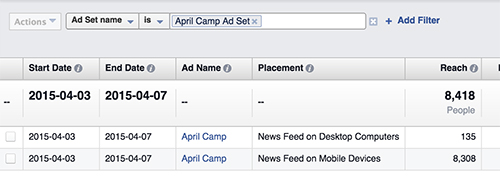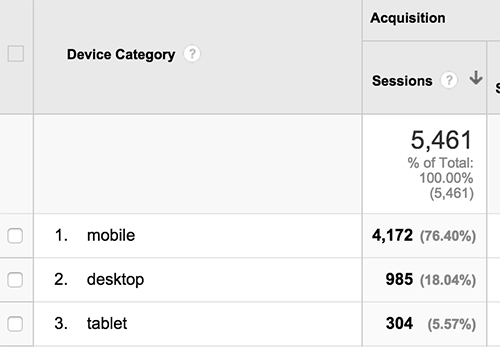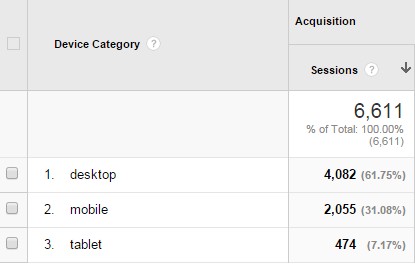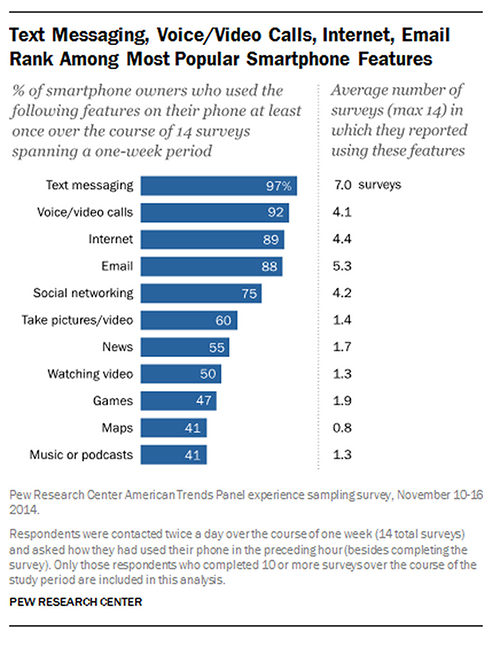3 Things You Need to Pay Attention to When it Comes to Mobile Experience
If you are not analyzing your platform with mobility in mind, you might as well just walk away from the computer.
With each passing year the importance and adoption of mobile technology continues to rise. With Google’s latest algorithm update, which rewards mobile friendly websites with higher rankings than their non-friendly peers, you have to pay attention.
Never before has so much power been available in the palm of your hand and never before have such a diverse group of people been taking advantage of it.
A new Pew Research Study dug into the impact that mobility has on today’s users and the results may surprise you.
Where We Are Today
You can no longer deny the impact mobile computing has had on business. Accessibility, convenience, and pure capability have resulted in 64% of American adults owning a smartphone today, up from 35% just 4 years ago.
Even more telling are the numbers of people that solely use their phone for internet access. In the study, it was found that 7% of users don’t have any other way of getting online other than their phone.
In my daughter’s case, she swears by her phone. In fact, she does most of her homework and research from the small screen versus using a conventional laptop.
Given the year over year growth of the market, and the elevated usage numbers, this market segment can no longer be ignored in your online strategy.
Gone are the days where you could get by just by having a website that rendered on the phone. Visitors to your site demand mobile-responsive websites or they bounce to the next option.
The following sections detail some of the findings from the report and also provide information that may help you identify how you should understand what it means to you.
1. You Have to Know Who is Holding the Phone
Understanding your audience is crucial to any business, online or not. You have to understand your avatar. With mobile this is especially true.
Looking at the data it becomes increasingly clear that if you want to reach a younger demographic, your efforts on mobile should be increased substantially, almost to the point where it should be considered your primary platform.
Case in point, one of my side projects right now is standing up an online/offline basketball training business. The clientele for this business is typically going to be young kids. Sure the parents are the ones that will ultimately be the ones paying, but you can’t deny the younger audience who runs back to them begging them for the training.
The data from the Pew study notes that 85% of young adults are smartphone owners and heavy users of the technology. As part of my analysis of a recent Facebook Ad campaign I ran for training I wanted to see how my mobile ads were doing compared to traditional desktop ads.
The numbers are staggering.
As you can see, overwhelming audience reach was accomplished via the mobile version of the ad. So much so that it makes me wonder if I should just simply feed the ad to mobile users.
Looking at the business website traffic over a period of time you could see the same trend.
Again, mobile dominated. Over 75% of the visitors were doing so via mobile technology.
This was an interesting finding and made me want to check against my Crazy Dad Life website. I pulled the stats for my site and this was the breakdown.
Now you can see how the audience demographic plays into your platform delivery. Since my audience is made up of older adults you can see a much higher number of desktop users than mobile users.
You must know who your visitor is so that you can understand how best to serve them.
Recommended Action
Take a look at your Google Analytics and take a peek at the number of visitors who accessed your site via a mobile phone. Start to track mobile visitors and really start to pay attention to bounce rates and other engagement metrics.
Try to understand the mobile experience. Start to test your site on your phone instead of only on your laptop.
2. Usage Has Expanded Way Beyond Just Email and Text
The study reinforces the most common use of people’s smartphones. Text messaging is the most widely-used smartphone feature and 88% of smartphone users in a sample period of time used email on their phone.
These two features remain more widely-used than social networking, watching video, or using maps and navigation.
But, use of the phone for other functions continues to rise.
More and more people are using their phones in new ways.
- 62% of owners used their phone in the past year to look up information related to their health.
- 57% use it for online banking.
- 44% have used it for looking up real estate information
- 43% have looked up employment information
- 30% use it for classes or other educational content
- 18% have actually submitted job applications with their phone
Again, this is especially true for the younger generation. Consider the following findings:
- 91% of smartphone owners 18-29 used social networking sites over a sample period of the report compared to only 55% of those 50 and older.
- 75% of younger owners indicated using their smartphone for watching video compared to only 31% of the 50 and older crowd.
- 64% of younger adults used their phone to listen to music or podcasts compared to a mere 21% of older users.
Take these numbers into consideration when developing your strategy. If your business revolves around retirement planning, perhaps a video strategy isn’t the best way to go.
What this means at a macro level is people are becoming more tolerant of the phone as a core tool in their daily life. Just looking at the online banking number should tell you the trust and confidence held by smartphone owners.
Recommended Action
What this means for you is that you can now open your business to the smartphone audience. They are willing to use the phone in new and exciting ways. Give it to them.
Think of your business and start to think of ways you can leverage the platform for your end users. Really start to include mobile strategy into your planning process.
3. You Don’t Have to be Mobile to be Mobile
Smartphones have now become go-to devices regardless of where you are physically located or what you are doing. In the past, they were mostly used for when you were out and about and needed a particular capability (e.g. calling someone), thus the term mobile.
Today, usage of smartphones happens everywhere. In fact, damn near everyone uses it at home.
You’ve heard the stories of everyone sitting around the family room on their phones, or eating out at a restaurant and everyone is on their device. Well, it’s true. People constantly use their phones. This really is not news to you.
But, you need to consider what this means in relation to your online platform. This means your opportunities are continuing to grow. Previous time spent offline and away from the screen is now being consumed by online access via mobile devices. While this may be good or bad depending on your philosophical viewpoint, it is a fact that can not be denied.
Recommended Action
You need to continue to provide content. The usage of the device at all times of day, at all locations, for all sorts of utility provide ample opportunity for you to feed your community.
Make sure you are constantly providing content that your audience can consume. Leveraging new and innovative ways to reach your audience can also help. Start to look at the tools and apps that are hot and think how you could implement in your business.
For instance, mobile video streaming is taking off like wildfire as of this writing. Periscope and Meerkat are battling for market supremacy and users are jumping onboard. Start to explore how this new medium might offer you new exposure.
For example, as a podcaster, you could live stream your broadcast. If you are an online marketer or someone that teaches online business, you could hold Q&A sessions then save the video and post to YouTube and Facebook for others to consume.
What to Do Next
Regardless of where you are within your current mobile capabilities and market strategy, you need to start working on it today.
Mobile growth is only going to continue to rise and if you want to survive and thrive in the new environment, you need to be ready.
Your first order of business is to get your website mobile friendly. I recently redesigned my site with the full intention of simply making the mobile experience top notch. Instead of screwing around with my own site and trying to “fix it”, I went out and invested in a premium theme. I have an affiliate relationship with StudioPress and highly recommend their themes. If you want to quickly fix your problems, check them out here.
Start to test your site, and all of its features, using your phone. Have your friends pull it up on different devices and provide feedback. It’s imperative that the user experience on your site, via mobile device, be impeccable and functional.
Keep mobile in your mind as you move forward. When you think of a new widget to add to your site or a new product you want to offer, always consider the impact of mobility.
How have you been incorporating the mobile user within your online platform? Sound off below and share your experience.





Leave a Reply